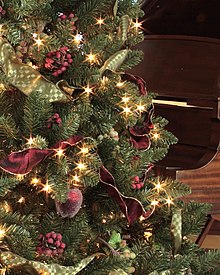
A Christmas tree is a decorated tree, usually an evergreen conifer, such as a spruce, pine or fir, or an artificial tree of similar appearance, associated with the celebration of Christmas.

The UL enterprise is a global safety science company headquartered in Northbrook, Illinois, composed of three organizations, UL Research Institutes, UL Standards & Engagement and UL Solutions.
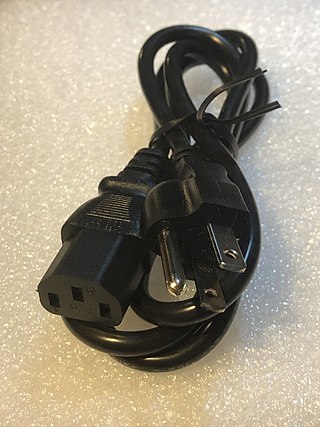
A power cord, line cord, or mains cable is an electrical cable that temporarily connects an appliance to the mains electricity supply via a wall socket or extension cord. The terms are generally used for cables using a power plug to connect to a single-phase alternating current power source at the local line voltage. The terms power cable, mains lead, flex or kettle lead are also used. A lamp cord is a light-weight, ungrounded, single-insulated two-wire cord used for small loads such as a table or floor lamp.

Christmas lights are lights often used for decoration in celebration of Christmas, often on display throughout the Christmas season including Advent and Christmastide. The custom goes back to when Christmas trees were decorated with candles, which symbolized Christ being the light of the world. The Christmas trees were brought by Christians into their homes in early modern Germany.

A product recall is a request from a manufacturer to return a product after the discovery of safety issues or product defects that might endanger the consumer or put the maker/seller at risk of legal action.
NOMA was a company best known for making Christmas lights. It was once the largest manufacturer of holiday lighting in the world. As of 2021, the rights to the brand in Canada and the United States are owned by Canadian Tire, which sells NOMA-branded products through its namesake stores in Canada, and through an e-commerce website in the United States.

Fire safety is the set of practices intended to reduce destruction caused by fire. Fire safety measures include those that are intended to prevent the ignition of an uncontrolled fire and those that are used to limit the spread and impact of a fire.

A nightlight is a small light fixture, usually electrical, placed for comfort or convenience in dark areas or areas that may become dark at certain times, such as at night or during an emergency. Small long-burning candles serving a similar function are referred to as "tealights".
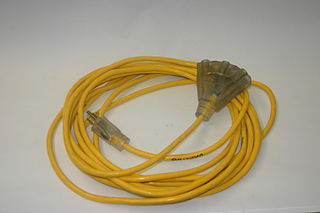
An extension cord (US), extension cable, power extender, drop cord, or extension lead (UK) is a length of flexible electrical power cable (flex) with a plug on one end and one or more sockets on the other end. The term usually refers to mains extensions but is also used to refer to extensions for other types of cabling. If the plug and power outlet are of different types, the term "adapter cord" may be used. Most extension cords range from around 2 to 30 feet in length although they are made up to 300 feet (91.44 m) in length.

A pilot light is a small gas flame, usually natural gas or liquefied petroleum gas, which serves as an ignition source for a more powerful gas burner. Originally a pilot light was kept permanently alight, but this wastes gas. Now it is more common to light a burner electrically, but gas pilot lights are still used when a high energy ignition source is necessary, as in when lighting a large burner.

Luminaria is a term used in different parts of the world to describe various types of holiday lights, usually displayed during Christmas. In English, the term most commonly refers to a specific type of simple paper lantern made by placing a votive candle in some sand inside a paper bag. Also known as a farolito, it is a traditional Christmas decoration in the Southwestern United States, particularly New Mexico, where it is a cultural hallmark of the Pueblos and Hispanos of New Mexico and a part of the state's distinct heritage. Luminarias are usually placed in rows along walls, roofs, and walkways to form a holiday display, especially on Christmas Eve.

An electric blanket is a blanket that contains integrated electrical heating wires. Types include underblankets, overblankets, throws, and duvets. An electric underblanket is placed above the mattress and below the bottom bed sheet. This is the most common type in the UK and Commonwealth countries, where it is known by default as an "electric blanket"; in the U.S. and Canada, where it is less common, it is called an electric heated mattress pad. An electric overblanket is placed above the top bed sheet, and is the most common type in the U.S. and Canada, where it is called an "electric blanket".
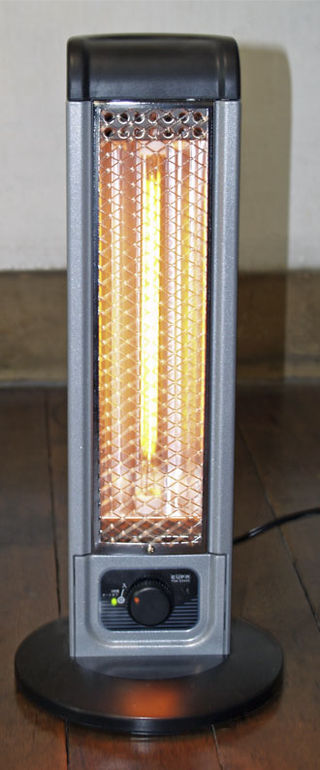
A space heater is a device used to heat a single, small- to medium-sized area. This type of heater can be contrasted with central heating, which distributes heat to multiple areas.

A thermal cutoff is an electrical safety device that interrupts electric current when heated to a specific temperature. These devices may be for one-time use, or may be reset manually or automatically.

The National Christmas Tree is a large evergreen tree located in the northeast quadrant of the Ellipse near the White House in Washington, D.C. Each year since 1923, the tree has been decorated as a Christmas tree. Every year, early in December, the tree is traditionally lit by the President and First Lady of the United States. Every president since Franklin D. Roosevelt has also made formal remarks during the tree lighting ceremony.

The Electrical Safety Foundation (ESFI), formerly the Electrical Safety Foundation International, is a 501(c)(3) non-profit organization based in Rosslyn, Virginia, US dedicated exclusively to promoting electrical safety at home, school, and in the workplace. Founded in 1994 as a cooperative effort by the National Electrical Manufacturers Association (NEMA), Underwriters Laboratories (UL), and the US Consumer Product Safety Commission (CPSC), ESFI is funded by charitable contributions from, distributors, Nationally Recognized Testing Laboratories, retailers, insurers, utilities, safety organizations, and trade and labor associations. The mission of the Electrical Safety Foundation (ESFI) is to prevent electrically-related injuries, deaths and fires; saving lives and property through public education and outreach.
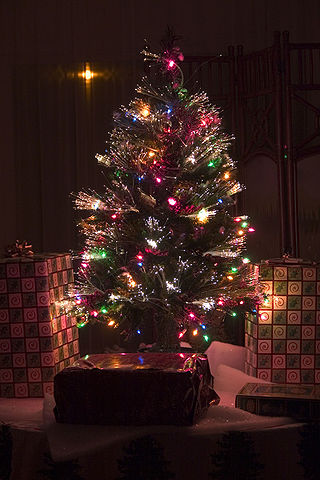
An artificial Christmas tree is an artificial pine or fir tree manufactured for the specific purpose of use as a Christmas tree. The earliest artificial Christmas trees were wooden, tree-shaped pyramids or feather trees, both developed by Germans. Most modern trees are made of polyvinyl chloride (PVC) but many other types of trees have been and are available, including aluminum Christmas trees and fiber-optic illuminated Christmas trees.

The Peace Candle is a tower-like structure erected every Christmas season in Easton, Pennsylvania. The approximately 106-foot (32 m) tall structure, which resembles a giant candle, is assembled each year over the Soldiers' & Sailors' Monument, a Civil War memorial located in the city's Centre Square. It is typically assembled in mid November and lighted over Thanksgiving weekend and disassembled in early February each year.

Stab-Lok is a brand name of electrical circuit breakers that were manufactured primarily by Federal Pacific Electric between 1950-1980. In June 1980, Reliance Electric, which had purchased FPE, reported to the United States Consumer Product Safety Commission that "many FPE circuit breakers did not fully comply with Underwriters Laboratories, Inc. (UL) requirements. Commission testing confirmed that these breakers fail certain UL calibration test requirements." Professional home inspectors now routinely recommend removing and replacing Stab-Lok breakers and panels that remain in service, as they may pose a fire hazard.

A self-balancing scooter is a self-balancing personal transporter consisting of two motorized wheels connected to a pair of articulated pads on which the rider places their feet. The rider controls the speed by leaning forward or backward, and direction of travel by twisting the pads.
